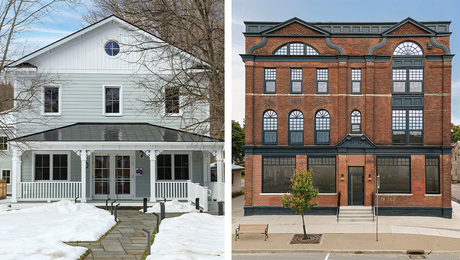I’m building a two story addition to my house and have a few odd questions.
1. Is there anything special that goes between the top of the concrete pier and the mud sill? Some kind of moisture barrier?
2. The NAFB web site mentioned a “gasket” between the bottom plate and the sub floor, but does not say what to use. What do you put here?
3. We are going to use some t&g on the interior walls. Would this allow air to infiltrate between the cracks. Should I do anything to account for this?
4. A lot of FHB articles have suggested using roof felt for the side wall moisture barrier. What kind of tape do you use when taping around windows etc? I have had trouble in the past with sticking.
Thank you for your help. If you have any other ideas on a tight building envelope please pass them along.



















Replies
1. Is there anything special that goes between the top of the concrete pier and the mud sill? Some kind of moisture barrier? No, but a foam gasket is usually placed between the top of a foundation wall and a mudsill.
2. The NAFB web site mentioned a "gasket" between the bottom plate and the sub floor, but does not say what to use. What do you put here? As I mentioned above, a thin, soft foam gasket is usually placed between the masonry and the mudsill. I have never heard of a gasket between the bottom plate and the subfloor. Usually subfloor adhesive is used here.
3. We are going to use some t&g on the interior walls. Would this allow air to infiltrate between the cracks. Yes, a lot.
Should I do anything to account for this? Probably, but you haven't entered any user profile info, so no one knows anything about your climate specific needs. This info is important when discussing vapor retarders, etc.
4. A lot of FHB articles have suggested using roof felt for the side wall moisture barrier. What kind of tape do you use when taping around windows etc? I have had trouble in the past with sticking. Just about any flashing tape should work. I like Vycor or Protecto Tape. Stickyness can be an issue in extreme cold, or if the paper is wet. The top flange gets taped to the sheathing.
Thank you for your help. If you have any other ideas on a tight building envelope please pass them along. This covers a lot of areas. Is there anything specific you are concerned with?
termite shield
Thank you for your help. The house is coastal South Carolina, near Charleston. The climate is hot and humid in the spring, summer, and early fall. A few cooler months in the dead of winter.
Considering the fact that some of the interior walls are going to be t&g what can I do to keep things tight?
I am also curious about the attic insulation. The roof will be a hip roof 8/12 pitch with exposed rafter tails. There will be an air handler in the attic. There are plans for 2 dormers with a vent. This is partly for looks and partly for venting. How to procede with venting and insulation?
Is there any particulr sub-floor adhesive for between the bottom plate and subfloor that you reccomend?
Thank you for your help.
I must be dense, but in case anybody else reads this as I do, why are you worried about air infiltration/movement with interior walls? or is the t&g going on the interior side of an exterior wall?
I don't think that you'll find that subfloor adhesive is "usually" used under exterior walls. Some guys do, and it probly seals things up a little better than nothing. PL premium is good shtuff.
Bing
Thank you for your help. The t&g is on the inside of an exterior wall.
Firstly, I stand corrected on the subfloor adhesive. I misread your question, and accordingly misstated an answer. Subfloor adhesive is NOT commonly used under plates. We normally don't use anything there although a couple of times we have used silicone sealant at this joint in an effort to get a super-tight shell.
As for your t&g walls, I assume these are interior finishes on exterior walls, no? For your climate, I think this will be OK, depending on your insulation plan. Which is???
For your attic, esp. w/ air handlers up there, conventional theory is that you want to keep that space within the thermal envelope, therefore, you should be looking at insulating the underside of the roof, or better yet, considering a hot roof with rigid foam on top of the deck.
Thank you for the help.
The plan was for fiberglass batts in the walls. We did not know if there were insulated J boxes or not. I've heard a lot of energy is lost there.
The roof is going to be five v metal. Will this affect the dense foam. Is it a good idea to also insulate the second story ceiling.
You might wish to check out Building Science Corporation website which offers numerous publications (many of which are available as free downloads) that address basic building issues for various climate zones in the US.
FG batts are considered by a few (a lot actually) as "old" technology. I think it's an OK material when done correctly (often it isn't), but various forms of cellulose and foam are emerging as superior materials.
Back to your question, if you are insulating the underside of your roof, it wouldn't be necessary to also do your second floor ceiling. Save your money put more insulation elsewhere.
Thanks for the info. I will check out the web site.
These videos will help you make a decision.
http://www.codecollegenetwork.com/video_center/
Thank you for the web site info.
The flexible foam under the bottom plate that RedfordHenry mentioned is called "sill seal" and comes in rolls--it is usually blue and corrugated along its length.
Some people don't seem to like tar paper (felt), but it does have an advantage in that it is black and so if it shows at all, it just looks like nothingness. You can also use rosin paper which is a pale redish color. The last engineered floor I helped put down had rosin paper under it.
Here is a pic of the sill seal that redford and dano spoke of. They sell it at Lowers and HD.
You definitely have to cover the walls with something other than poly sheeting to stop air passage into and out of the t&g. The amount of air that will pass right through it is amazing. Plywood under the t&g is what I'd do. It seals the wall and holds nails well.
When using felt in place of house wrap I think it's wishful thinking to use tape of any kind and expect it to stick to the felt. I run a foot or more of ice and water around the opening and tape the window to it. The felt simply overlaps the ice and water except at the bottom where the felt is under the ice and water at least a few inches.
Same for corners, ice and water with felt overlapping it.
Beer was created so carpenters wouldn't rule the world.
Thank you for your comments. The wind and ice shield first sounds like a great idea. I am still trying to make up my mind on the wall business. The house will have fiber cement siding, felt paper, plywood sheathing, insulation, and then the 3/4" t&g paneling. Do think that another layer of plywood behind the t&g is necessary? Or would another air barrier be the way to go? Or something else?
Thank you for any other help.
Not sure if you're talking about big-format paneling (i.e. 4x8 or so) or beadboard for your interior finish. If the latter, I'd definitely go w/ the plywood underlay. I spent this time last year fixing up a 60-year-old beadboarded room in my house. It's a bonus room, and I opted to have poly foam sprayed from the attic side rather than try to detail it to eliminate all the air infiltration.
My vote is for wet-sprayed cellulose for your wall insulation. Much easier to get a good install than fiberglass. And I think most folks would agree that the cost to have someone put in insulation is typically only marginally higher than DIY.
Check out Southface (http://www.southface.org) for the EarthCraft Home program. They're active in SC, I believe. Even if you don't want to go to the expense of having the house certified, there's lots of good info there on air sealing and insulating.
FWIW, I caulked the sills to the subfloor in our addition. Think that's an acceptable alternative to the gasket. I assume you'd tack the gasket to the sill or subfloor before putting up the wall assembly- it'd be a PITA otherwise.
Getting t&g tight requires a bit of wedging/prying and it rips many holes in any kind of easy to use air barrier such as poly sheeting. Drywall won't hold the nails required to keep the t&g tight and searching for a nailer behind sheetrock is time wasted. Plywood is what I'd use.
T&G isn't a low cost covering if it's done right. If it's done wrong air goes through it like pooop through a goose.
Beer was created so carpenters wouldn't rule the world.